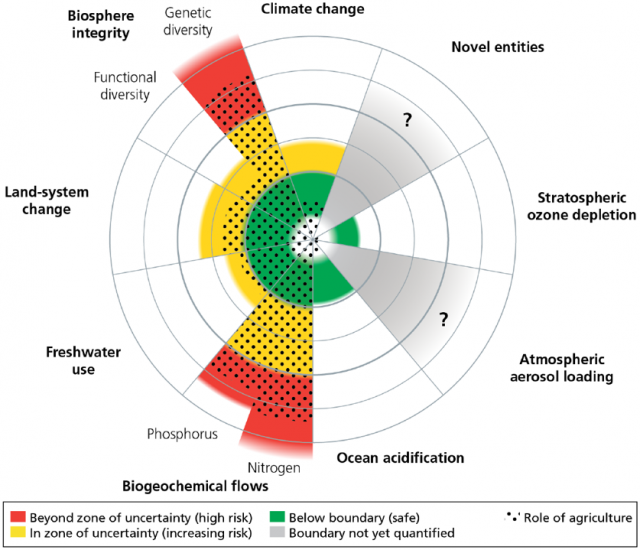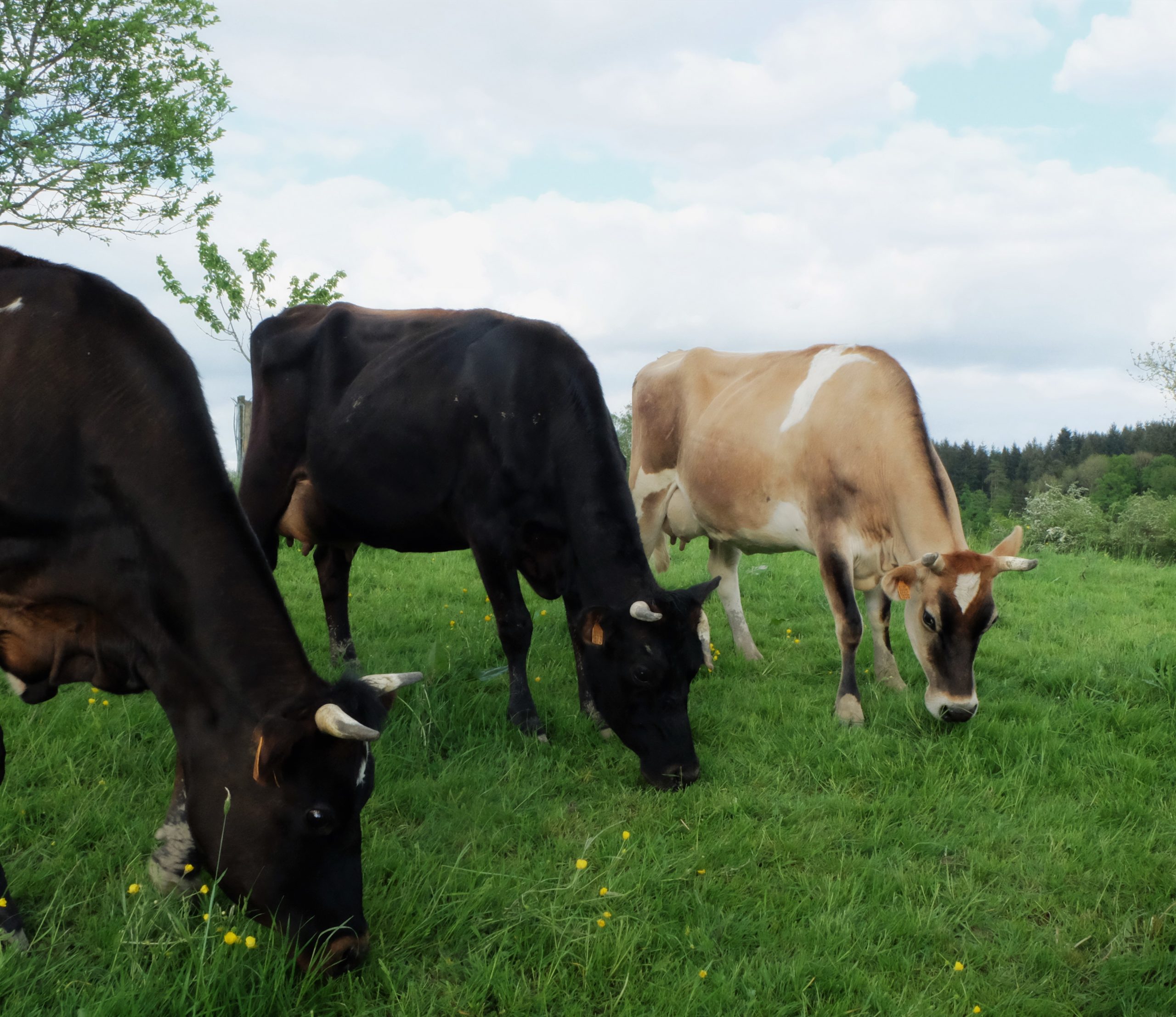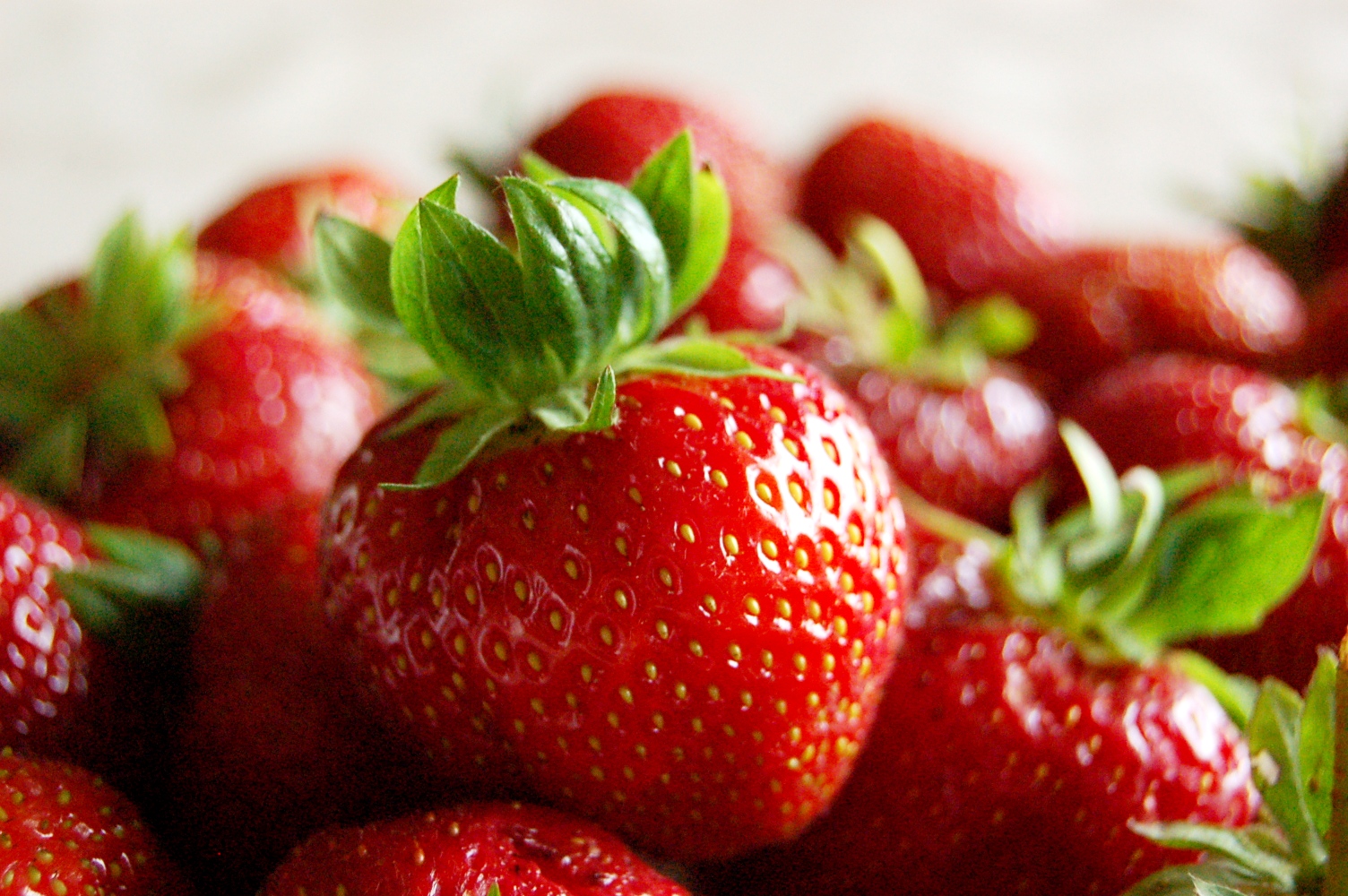Addressing the sustainability dimension of EU food production 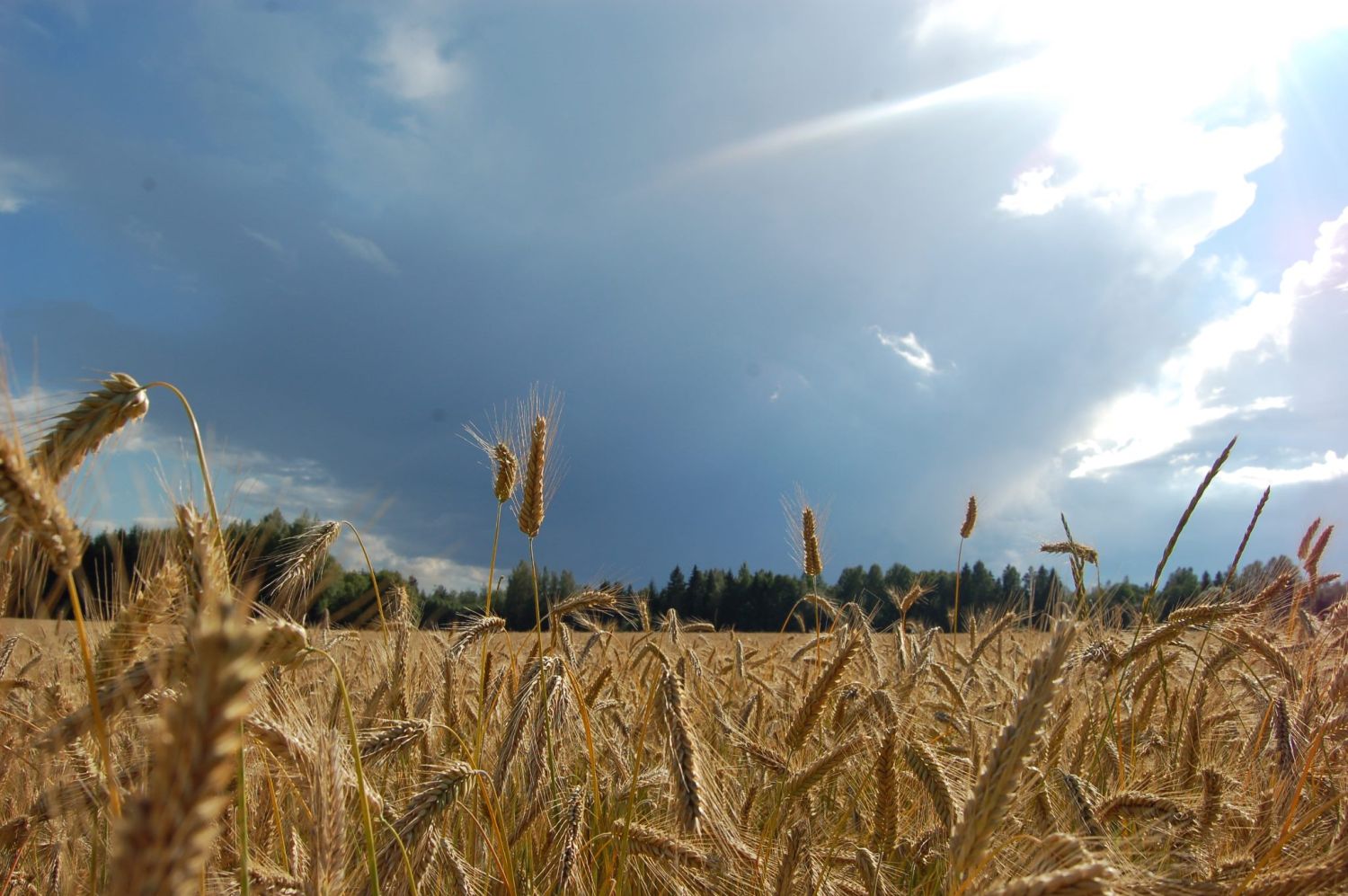
Agriculture and land management
Since the 1960s the emphasis on increasing agricultural output through investments in capital, labour and inputs (mechanisation, use of pesticides and fertilisers, etc.) has significantly increased the EU’s productive capacity with a dramatic increase in specialist cereal and meat production.* Until the early 2000s, these developments were largely encouraged by price support schemes under the CAP which led to over-production. Over time this emphasis on production and increasing productivity led to dramatic structural changes with a shift away from low-intensity mixed farming systems towards regional specialisation, intensification and land abandonment throughout Europe, threatening the long-term sustainability of agro-ecosystems.† This has seen cereal and oilseed crops covering the majority of arable areas and the rapid growth of cattle production, especially dairy, but without an increase in grazing areas due to yield improvements, breeding and animal feed imports (Box 3).‡
Box 3: Intensive livestock production and climate change
The livestock sector in particular has seen dramatic changes over the last decades. Global meat production has quadrupled between 1961 and 2010, with milk production more than doubling and egg production increasing more than fourfold (HLPE, 2017). In recent years, the negative impacts of intensive livestock production practices on the environment and climate have come under increasing scrutiny, including Europe’s dominance as a consumer of natural resources beyond its borders (Godfray et al., 2018; Gerber et al., 2013). Global trends show a growing concentration of intensive livestock production in certain regions of the world, particularly within the pig and poultry sectors, but also increasingly in the beef and dairy sectors. In 2016, the EU-28 together with Brazil, China, and the United States were collectively responsible for 62.3% of total world meat production.
In the EU-28, consumption is double the world average for meat, and triple the world average for milk. The livestock sector is also highly dependent on imported animal feed (Westhoek et al., 2011). In 2013 the EU was a net importer of around 27 million tonnes of soybeans and soya products for oil production and animal feed (EEA, 2014). Imported feed has had a significant impact on deforestation globally, with 44% of deforestation associated with the EU consumption of animal feed crops between 1990 and 2008 (Cuypers et al., 2013). The livestock sector is also a significant emitter of greenhouse gas emissions (GHG). Indeed to achieve an 80% cut to its GHG by 2050, it is estimated that the livestock sector would need to contract by up to 74% (Buckwell and Nadeu, 2018). The challenge therefore is how to manage complex trade-offs to enable livestock’s positive impacts to be realised while minimising and mitigating negative ones, including threats to the health of people and the environment. For example, low-intensity livestock systems can utilise land otherwise unsuitable for food production and support the management of highly biodiverse grasslands (Bignal and McCracken, 1996; Karp, 2012).
However, these specialist and intensive agricultural practices exert significant pressure on the natural environment and climate both within and outside the EU. This increases the environmental footprint of EU agricultural production and contributes to agri-food systems exceeding their planetary boundaries (Figure 3).§
Evidence documented in the latest European environment state and outlook report¶ clearly demonstrates that the agriculture sector continues to place significant pressures on the climate and degradation of natural resources such as biodiversity, air, water and soil across farmed landscapes and that these impacts are felt both inside and outside Europe. In particular:
- Agriculture intensification continues to remain a main cause of biodiversity loss including agrobiodiversity (Box 4). Biodiversity decline is evident in the downward trends in farmland birds and grassland butterflies between 1990-2016 and 1990-2017 respectively#;
- Evidence from across Europe shows increasing concern about the residence and accumulation of pesticide residues in soils.** There also appears to be a continuing dependency on pesticides with sales remaining relatively constant between 2011-2016††;
- Nitrogen loads have improved between 2000 and 2010, but there has been no further improvement between 2010 and 2015 and a surplus of nitrogen on EU agricultural land remains, with hotspots in certain regions‡‡; and
- About 10% of GHG emissions come from the agricultural sector and while these have decreased since the 1990s, emissions from livestock and soils have been increasing again since 2012.§§
Box 4: Role of agrobiodiversity in food and farming systems
Agrobiodiversity refers to the variety of plants and animals used in food and agriculture. Agrobiodiversity not only provides the basis for food security (FAO, 2015) by supporting the provision of ecosystem services, but also helps to support productivity and facilitate dietary diversity (Mouillé et al., 2010; FAO, 2004).
There are estimated to be more than 50,000 edible plant species worldwide (FAO, 1995) with only 7,000 species consumed and 150 deemed commercially important. About 103 species make a significant contribution to the human food supply chain and are under threat due to agricultural intensification and specialisation (Thrupp, 2000). It is estimated that 90% of the world’s food energy intake is only provided by just 15 crop species (FAO, 1995). Many of the under-utilised crops not only have excellent nutritional profiles, but are based on thousands of years of farmers selecting and producing various edible species suited to different social and environmental contexts.
The emphasis on specialisation of production systems as part of a move to greater economic efficiency has resulted in global food supply being centred on three cereal crops – maize, rice, and wheat. At the turn of the century it was estimated these crops contributed to around 60% of the calories consumed by humans either directly or indirectly (as animal feed). Due to their high yield potential and ease of storage and transportation they are considered the main sources of human food supply (Cassman et al., 2003) despite the breath of global agrobiodiversity (IAASTD, 2009). However, the conservation and sustainable use of agrobiodiversity, in particular preserving plant varieties and rearing endangered breeds, has become more critical than ever as agricultural systems consider how to become more resilient to climate change (FAO, 2011).
The loss agrobiodiversity is therefore a significant threat to food security as it not only undermines the diversity of production and resilience of agricultural systems, but also the diversity of what makes up a sustainable diet.
These trends clearly demonstrate the environmental and climate pressures resulting from agricultural practices that have become unsustainable and highlight the importance of putting environmental and climate considerations at the centre of future agricultural production methods (and hence EU agricultural policy). This is necessary to ensure production and yield stability in agricultural systems are resilient to future climatic changes as part of contributing to food security.
Pathways towards more sustainable food and farming systems
While there is a growing consensus that fundamental changes are required to address the pressures posed by current production methods, there is less scientific or political agreement on which development pathways are needed to confront the scale of the sustainability challenges (e.g. organic farming, conservation agriculture, agroecology, ecological intensification and sustainable intensification). As illustrated by the efficiency, substitution and redesign framework, there are those who consider that incremental change is needed to move from input-intensive industrial systems towards solutions based on increased efficiencies and input substitution (e.g. relying on the use of alternative inputs to agrochemicals). On the other hand, there are those who consider that more radical change is necessary where preventative solutions are put in place based on a fundamental redesign of the agroecosystem (Figure 4).¶¶
Figure 4: Efficiency, substitution and redesign framework
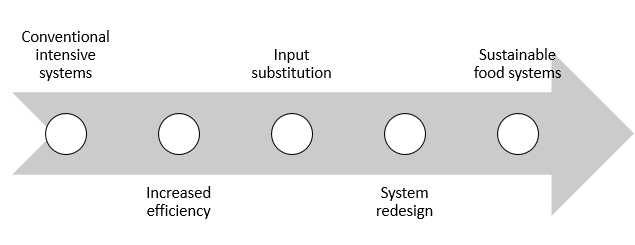
Many of these development pathways are often framed by policymakers in terms of their ability to feed the world. The most notable binary pathways proposed are sustainable intensification## and agroecology*** although there is significant crossover between the two†††. On the one hand sustainable intensification is generally seen to be about increasing production through greater efficiencies that consider environmental protection and resource management. Yet these approaches could potentially lead to continued reliance on inputs and the use of contested technologies such as genetically modified (GM) as well as new genetic engineering techniques for breeding. This reflects the fact the original sustainable intensification concept was designed to be deliberately non-prescriptive in terms of the technologies or practices that can be adopted in order to give farmers the flexibility to apply different approaches relevant to their needs.‡‡‡ For example, in a European context given the high intensity of agricultural production, sustainable intensification it is argued, is about increasing the intensity of knowledge as to how physical inputs can be combined and managed in order to deliver resource efficient agriculture with significantly higher environmental performance.§§§ Nevertheless the concept is not uniformly understood with many considering it not to be a major departure from current agricultural practices due to the lack of common definition.¶¶¶
On the other hand agroecology is seen to be about ‘system redesign’ as opposed ‘input substitution’ where agroecosystems are developed to work with nature and farmers, and where farmers’ knowledge has a central role, and there are efforts to make greater links between producers and consumers.###
Currently, organic farming is the only codified form of agroecology that has a prescribed combination of practices designed to minimise environmental impacts with the produce marketed at a premium to consumers in recognition of these efforts.****
There is also emerging evidence that organic farming not only helps to reduce environmental and climate impacts, but could make an important contribution to food security, if there is a significant overhaul in current food consumption (Box 5).
Box 5: The potential contribution of organic farming to food security
In 2018 organic farming represented 7.5 % of total EU farmland with total retail sales in the EU valued at 37.4 billion euro (Willer et al., 2020). While there is a largely body of evidence (Reganold and Wachter, 2016) demonstrating the positive contribution to food and farming systems, including greater profitability and environmental performance compared to conventional farming, the role of organic farming in feeding the world is widely contested (Connor, 2008) due to the lower yields and the potential extra land needed to meet the gap. Studies shows organic yields gaps can range from being 20% lower on average depending on crop type and location (Seufert et al., 2012) or about 10% lower on average when there are greater similarities between the farming systems e.g. similar amounts of nitrogen only coming from manure or n-fixing crops are applied or where entire rotations are taken into account (Ponisio et al., 2015). Recent assessments of the potential for organic farming to feed the world, suggest that it can play an important role in global food security, when an overhaul of current consumption patterns are taken into account.
From a global perspective, based on the FAO 2050 projections, it is estimated that 60% of the world’s nutritional needs could be achieved with organic farming if half of animal feed and food waste was reduced globally. This transition could significantly decrease a number of environmental impacts associated with reductions in nitrogen applications and pesticide use, lower greenhouse gas emissions, and only a marginal increase in farmland. In a European context, another study estimates that full conversion to organic farming by 2050, increases in ecological infrastructure and the redeployment of grasslands, including the extensification of livestock production, could feed up to 530 million people. This would result in a 40-47% reduction in GHG as well as positive environmental impacts associated with the phasing out of pesticides and introduction of more biologically diverse landscapes. Both assessments inevitably rely on significant changes in current dietary patterns and a major reduction in meat consumption in particular (Aubert et al., 2019).
Changes in dietary patterns and sustainable diets
The predominant focus on agricultural production within policy debates in the EU has meant far less attention has been paid to consumption patterns and diets. Moreover, a common assumption is made that Western consumption patterns will continue and should be an aspiration.†††† While the concept of sustainable diets – as being consistent with good health and low environmental impact – has been around since the 1980s‡‡‡‡, the need to consider sustainable production and sustainable diets together has received growing recognition in more recent years articulated through ‘food sustainability’ narratives in relation to food security§§§§. Sustainable diets are considered to be inextricably linked to both human health and environmental sustainability.¶¶¶¶ While improving production practices and increasing crop yields and access to food has contributed to alleviating some global food security challenges, to some extent these benefits are being off-set by a shift to more energy intensive diets which are heavily-processed and contain higher amounts of protein from animal sources.#### Moreover, food choices are increasingly made within a food environment***** which influences consumer purchases depending on availability, affordability, convenience, and desirability of various foods. The food environment also takes account of physical, economic, policy and socio-cultural factors that may affect people’s choices and nutritional status such as food composition, food labelling, food promotion, food prices, food provision in schools and other settings, food availability and trade policies affecting food availability, price and quality. †††††
European diets have also changed significantly over the last 50 years. Between 1961/1965 and 2000/2004 dietary patterns in EU countries saw a convergence towards more westernised diet particularly in Mediterranean countries.‡‡‡‡‡ consume food products that are characteristically energy-dense, fatty, high in sugar or salt) has increased significantly over the last few decades. The largest amounts of these products, which are usually highly-palatable, cheap and generally contribute to obesity, are consumed in high-income countries, however there is also rapid growth seen in middle‐income countries.§§§§§ In European countries ultra-processed foods can amount to over a quarter of food purchases on average ranging from 10% in Portugal to 50% in the UK. There is also a significant positive association between the availability of ultra-processed foods and national prevalence of obesity amongst adults.¶¶¶¶¶ The shift away from diets based on regular freshly prepared meals has significantly transformed food supplies, food culture and dietary patterns in many parts of the world, with the sale and promotion of ultra-processed food and drinks now considered a major driver of global epidemics of non-communicable diseases.#####
These trends have significant implications for both environmental and human health. For instance European consumption of meat and dairy alone has increased dramatically over the last 50 years leading to range of negative environmental impacts both in and outside Europe, as well as human health risks, with consumption 70% higher than recommended dietary guidelines.****** Poor dietary patterns also contribute to poor health outcomes due to people becoming overweight or obese. In Europe, over half of adults and over a quarter of school-age children across Europe were overweight and increased significantly in all age groups between 2000 and 2018.†††††† EU figures show obesity rates have risen in almost all European countries since 2000 and in 2014. About 16% of adults were categorised as obese across all Member States as a result of energy-dense foods and less active lifestyles.‡‡‡‡‡‡ Indeed there is growing evidence that major region-specific changes to our current dietary patterns are required to support better human and environmental health by 2050. In a European context this includes significant reductions in the consumption of animal products, and an increase in fruit and vegetables, nuts, and legumes (Figure 5).
Figure 5: Recommended regional dietary changes required by 2050 to say within planetary boundaries
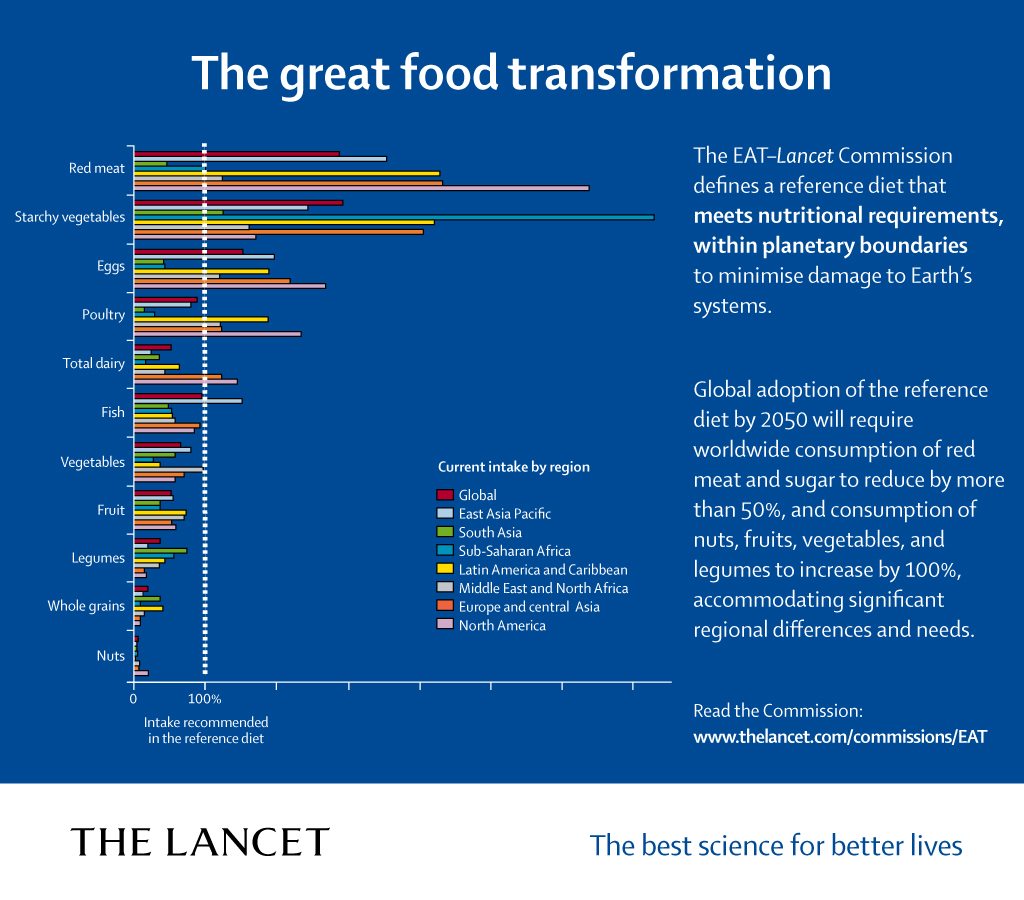
These trends show the growing importance of sustainable diets as part of the overall challenge of addressing the sustainability dimension of food production and highlights the need for a broader approach to food security in the EU policy debate that goes well beyond the farm scale.
Role of the CAP in sustainable food production
Despite these current pressures and trends, it is important to acknowledge that there have been some improvements in the sustainability of EU food production. This largely relates to improvements in the sustainability of farming practices and land management, particularly as a result of successive reforms of the CAP.§§§§§§ This reflects the fact that, as the largest source of EU funds (representing approximately 40% of the EU budget in 2018¶¶¶¶¶¶) and public expenditure targeted at the agricultural sector, the CAP influences the business and management decisions of farmers through a combination of rules and incentives. The CAP has progressively shifted away from supporting farmers through price and production support schemes since the mid-1990s towards offering direct payments to farmers decoupled from production as a new form of income support as well as placing more emphasis on the environment and rural development (Figure 6).######
Figure 6: CAP expenditure 1990-2020
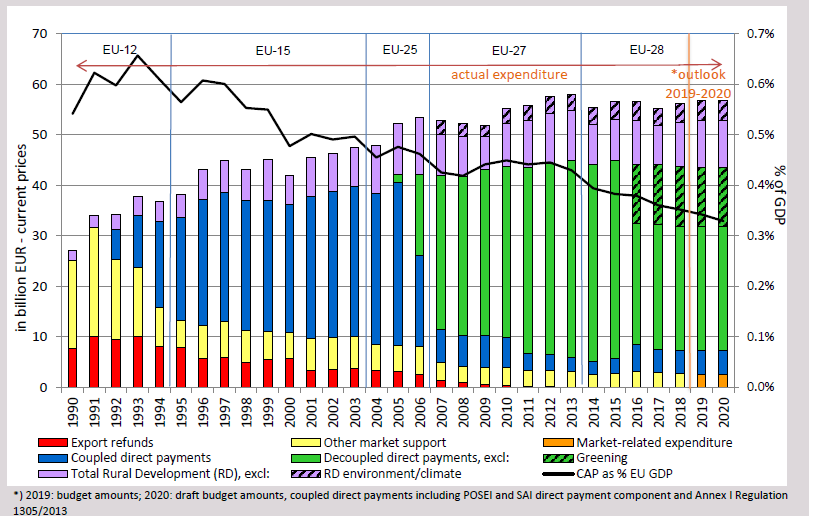
The policy has also placed more emphasis on complying with basic environmental requirements, with the introduction of cross-compliance in the mid-2000s. A stronger focus was also put on sustainability with the introduction of measures to support more sustainable land management through the establishment of compulsory agri-environment schemes and voluntary support for organic farming which are now a central component of EU rural development programmes. For example, agri-environmental commitments covered 26.3 % of the EU farmland area for the period 2007-2013 (including organic farming and excluding Croatia), while the commitments for the period 2014-2020 are expected to cover about 22.5% of the area by 2020 (excluding organic farming).******* Although these figures are not directly comparable (as a result of the way the data has been compiled and reported) and the degree of scheme targeting can vary significantly, they demonstrate the important role rural development programmes have and continue to play in supporting sustainable agriculture and land management in the EU. Support for conversion and maintenance payments for organic farming have contributed significantly to the growth of the organic farmland between the mid-1990s and 2014.††††††† Moreover, the current CAP 2014-2020 is expected to support further conversion to organic farming by 2020. However, when compared to the total organic farmland area in 2014 these increases to 2020 appear to be modest in many Member States.‡‡‡‡‡‡‡
Nevertheless, environment and climate objectives have become gradually more prominent within the CAP over time – particularly since the last reform. In this 2013 reform there were further efforts to mainstream environmental and climate considerations into direct payments with the introduction of ‘greening’ measures. This had the potential for up to one third of the total CAP budget to be targeted at land management actions to address environmental and climate priorities based on the principle of public money for public goods.§§§§§§§ However, the results of the ‘greening’ measures have been extremely mixed to date. Firstly a significant proportion of the EU’s farmland area was exempt from the requirements and secondly the actual implementation choices, which primarily targeted arable land, were taken by Member States and largely driven by efforts to avoid changes to existing farming practice and avoid administrate burden.¶¶¶¶¶¶¶ As result the greening payments have had a limited impact on increasing sustainable land management and action on climate change in the EU agriculture sector.####### Moreover between the two programming periods 2007-2013 and 2014-2020, the total allocation of rural development spending for agri-environment and organic farming has been reduced significantly across a number of Member States.********
The latest reform of the CAP for post-2020 is presented as new departure in supporting the transition towards a more sustainable agricultural sector, through a new delivery model focused on results and greater accountability. This is intended to increase the level of ambition environmental and climate ambition of the policy. This is a positive development, particularly in terms of using direct payments in a targeted way to support the transition toward more sustainable land management. It can also help to complement land management support under the rural development programmes, as long as sufficient funding is provided for all elements of the policy needed to drive the necessary change. However, there are caveats, notably the fact that basic income support continues to remain a dominant component and could trump these new innovations in the policy.††††††††
While the majority of the CAP funds remain focused on providing income support to farmers, measures available under the rural development programmes have increased support for initiatives that could that have the potential to stimulate sustainable food production as well as influence sustainable dietary patterns to some extent through changes to the food environment. These measures largely concern the restructuring, modernisation or development of farm and food businesses as well as Community-led Local Development/LEADER. The development of short supply chains has also been given greater prominence in the current CAP 2014-2020.‡‡‡‡‡‡‡‡ There is evidence that Member States are using these measures to support food supply initiatives at regional and local level.§§§§§§§§ However, there is no CAP objective or rural development priority that is explicitly aimed at promoting sustainable food production across the supply chain or designed to influence sustainable dietary patterns specifically. Thus while some measures have the scope to support health and nutrition outcomes in principle, the specific contribution and overall effectiveness of such measures in supporting sustainable diets remains unclear. There are also no clear policy signals as to why they should receive political priority in agricultural policy. This lack of political prioritisation is also exacerbated by the fact that they are seen as secondary to economic concerns.¶¶¶¶¶¶¶¶ In contrast, the post-2020 CAP does place more emphasis on these issues including a specific objective on the role of EU agriculture in addressing societal demands for more sustainable food production and reducing food waste. However, there is no specific target designed to monitor or measure the delivery of more sustainable diets under the proposal. As a result, it remains unclear how Member States are to address this objective in practice to ensure a greater coherence between agriculture and health and nutrition policies as part of a more integrated approach to European food security.
Despite the resources available within the CAP to support sustainable food production it is evident that the policy only influences some dimensions of food security. Indeed prior to the launch of the European Green Deal, there are already a number of other instruments across the EU policy framework, beyond the CAP, that can influence the development of EU food and farming systems both directly and indirectly to 2050 (Figure 7).########
Figure 7: Non-exhaustive overview EU food and sustainability polices prior to the Green Deal
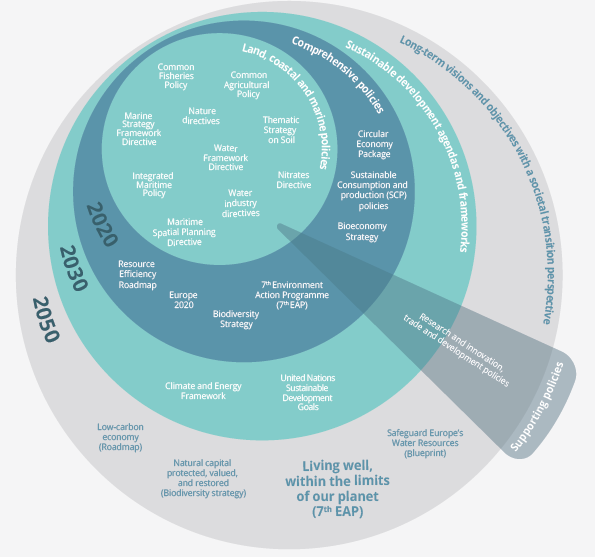
Full consideration of these policies is also critical in the formulation of any comprehensive response to food security in an EU context. For example, the EU Structural Funds have the potential to support the development of sustainable food distribution networks to improve the availability and the stability of supply. Investments in green public procurement and fiscal policies such as taxation can influence how sustainable food is utilised and can be accessed affordably. Elsewhere policies concerning climate change, research and innovation and the circular economy can help to improve the stability of both food production and supply. Finally, trading practices between different actors in the food chain and trade agreements between the EU and other countries can address all dimensions of food security in terms of fair market prices and ensuring sustainable livelihoods for producers.
Overall the evidence of the challenges facing agriculture and land management and diet patterns in Europe, coupled with the design and implementation of the current CAP and lack of consistency between EU policies to address these challenges, clearly demonstrates the need for more coordinated action across EU policies in terms of the way they are implemented. The EU’s Farm to Fork Strategy, as part of the overall EU Green Deal, therefore has the potential to bring together these policies to address food security in a more sustainable way.
